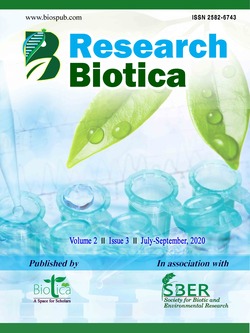
Phytochemical Analysis and Antibacterial Efficacy of Ethanolic Extract of Musa paradisiaca
B. Deepa*
Dept. of Biochemistry, D. G. Government Arts College for Women, Nagapattinam, Mayiladuthurai, Tamil Nadu (609 001), India
Dept. of Biochemistry and Biotechnology, Annamalai University, Annamalai Nagar, Tamil Nadu (608 002), India
T. Sivakumar
Dept. of Botany, Thiru A. Govindasamy Govt. Arts College, Tindivanam, Tamil Nadu (604 307), India
Dept. of Botany, Annamalai Nagar, Tamil Nadu (608 002), India
DOI: https://doi.org/10.54083/ResBio/2.3.2020.126-130
Keywords: Alkaloids, Antibacterial activity, Musa paradisiaca, Phytochemicals, Solvents, Total Phenols
Abstract
The antibacterial activities of the extract of Musa paradisiaca L. were evaluated against Staphylococcus aureus, Bacillus subtilis, E. coli. Ethanolic extract (MPE) of Musa paradisiaca L. were obtained by standard methods. The antibacterial activity was assayed using agar well diffusion method. The MPE exhibited antibacterial effects with inhibiting zones ranging from 3.09 ± 0.01 mm to 8.53 ± 0.01 mm. The extract showed appreciable quantity of total phenol (Gallic acid equivalent) of 23.12 Mg GAE g-1. The higher phenolic content of MPE may be responsible for its antibacterial activity. This study shows that useful bioactives component that can be used in food processing industries.
Downloads
not found
Reference
Akpabi, U.D., Udiong, D.S., Akpakpan, A.E., 2012. The Physicochemical characteristics of plantain (Musa paradisiaca L) and banana (Musa sapientum) pseudo stem wastes. Advances in Natural and Applied Sciences 6(2), 167-172.
Akpuaka, M.U., Ezem, S.N., 2011. Preliminary photochemical screening of some Nigerian dermatological plants. Journal of Basic Physical Research 2(1), 1-5.
Asquith, T.N., Butler, L.G., 1986. Interaction of condensed Tannins with selected proteins. Photochemistry 25(7), 1591-1593.
Ayoola, G.A., Coker, H.A.B., Adesegun, S.A., Adepoju-Bello, A.A., Obaweya, K., Ezennia, E.C., Atangbayila, T.O., 2008. Phytochemical screening and antioxidant activities of some selected medicinal plants used for malaria therapy in Southwestern Nigeria. Tropical Journal of Pharmaceutical Research 7, 1019-1024.
Ciulci I., 1994. Methodology for the analysis of vegetable drugs. Chemical industries branch, Division of industrial operations, UNIDO, Romania. pp. 24-26.
Dahiru, D., Malgwi, A.R., Sambo, S.H., 2013. Growth Inhibitory Effect of Sennasiamea Leaves Extracts on Selected Microorganisms. American Journal of Medicine and Medical Sciences 3(5), 103-107.
Edeoga, H.O., Okwu, D.E., Mbaebie, B.O., 2003. Mineral and nutritive value of some Nigerian medicinal plants. Journal of Medicinal and Aromatic Plant Sciences 25, 689-694.
Fatope, A.O., Ibrahim, H., Takeda, Y., 1993. Screening of higher plants reputed as pesticides using brine shrimp lethality bioassay. International Journal of Pharmacognosy 31, 250-256.
Ghani, A., 2003. Chemical constituents and uses. In: Medicinal Plants of Bangladesh, 2nd Edition. Asiatic Society of Bangladesh.
Karadi R.V., Shah, A., Parekh, P., Azmi, P., 2011. Antimicrobial activities of Musa paradisiaca and Cocos nucifera. International Journal of Research in Pharmaceutical and Biomedical Sciences 2(1), 264-267.
Khare, C.P., 2007. Indian Medicinal Plants: An Illustrated Dictionary. First Indian Reprint, Springer (India) Pvt. Ltd., New Delhi. p. 843.
Kim, S.Y., Kim, J.H., Kim, S.K., Ohandy, S.K., Jung, M.Y., 1994. Antioxidant activities of selected oriental herb extracts. Journal of the American Oil Chemists' Society 71, 633-640.
National Committee for Clinical Laboratory Standards (NCCLS), 2008. Performance standards for Antimicrobial Susceptibility Testing: Ninth Informational Supplement. NCCLS document M100-S9. National Committee for Clinical Laboratory Standards, Wayn PC.
Osuagwu, G.G.E., Okwulehie, I.C., Emenike, J.O., 2007. Photochemical and Mineral content of the leaves of four Nigerian Pterocarpus species. International Journal of Molecular Medicine and Advance Sciences 3(1), 6-11.
Pintu, K.D., Arna, P., 2014. Effects of aqueous young leaves extract of Mangifera indica on Gram negative microorganisms causing gastrointestinal disorders. Asian Journal of Plant Science and Research 4(1), 23-27.
Ponmurugan, K., Muhammed, M., 2013. Antibacterial and antioxidant activities of Musa species leaf extracts against multidrug resistant clinical pathogens causing nosocomial infection. Asian Pacific Journal of Tropical Biomedicine 3(9), 737-742.
Sandhya, B., Thomas, S., Isabel, W., Shenbagarathai, R., 2006. Ethnomedicinal plants used by the Valaiyan community of Piranmalai hills (reserved forest). Journal of Complementary and Alternative Medicines 3, 101-114.
Sofowara, A., 1993. Medicinal Plants and Traditional Medicine in Africa. 2nd Edition. Spectrum Books. Nigeria. pp. 10-158.
Sunil Jawla., Kumar, Y., Khan, M.S.Y., 2012. Antimicrobial and antihyperglycemic activities of Musa paradisiaca L flowers. Asian Pacific Journal of Tropical Biomedicine 2(2), 914-918.
